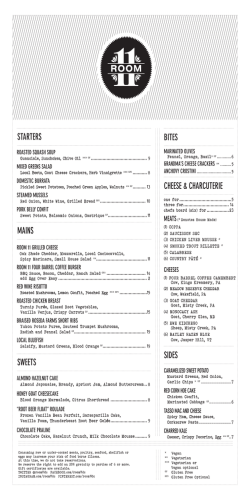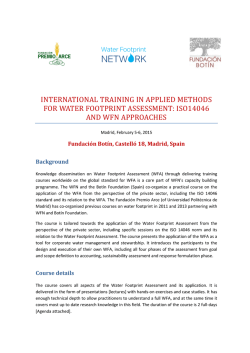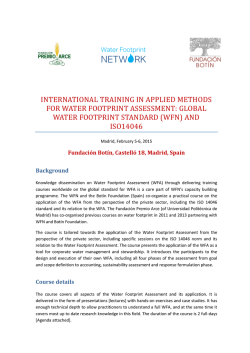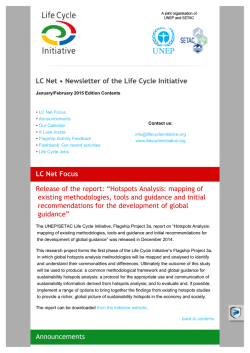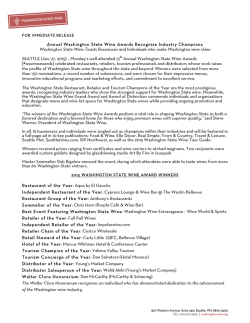
Water Footprint and Environmental Impact Assessment of an
Environmental Impact Assessment of an Industrial Activity based on Life Cycle Analysis and Water Footprint Concept V. S. Koutantelia and M. P. Papadopoulou School of Rural and Surveying Engineering, National Technical University of Athens, Athens, Zografou, 15780, Greece Keywords: life cycle analysis, environmental impact assessment, water footprint, vinification Presenting author email: [email protected], [email protected] ABSTRACT Nowadays due to the high consumption of water in agriculture, industry, energy production and domestic use, an urgent need for water accounting at Life Cycle Analysis level is required. This paper focuses on a vinification case study applying Life Cycle Analysis (LCA) in Water Footprint (WF) concept. The calculations refer to a small-size wine production industry in Polydrosos, Greece with a production line of ≈197000 wine bottles (750ml) per year. The WF estimation and environmental impact assessment are based on the production-chain diagram presenting inputs and outputs for each process stage. The main processes considered in this case were: cultivation, vinification, creation of packaging materials and final product whereas the transportation phase was excluded. The WF of a 750ml bottle of wine was varied between 1565,77lt to 1757,16lt depending upon the adopted WF approach. The results indicated that 99,6% of the total WF is related to the supply-chain water consumption and only 0,4% to the operational one. The analysis showed that the selection and origin of raw materials need to be considered prior in order to achieve an optimal water resources management plan for a region. Additionally, in the impact assessment phase of LCA, cultivation process appears to be a “hotspot” for wine production that affects mostly the system. In conclusion, by identifying processes that have potential for improvement LCA was proved to be an important tool for sustainable development of high water consumption industries. 1. Introduction Water is one of the most important natural resources that affect humans’ life both in terms of survival, but also in their development. However, modern lifestyle, overpopulation and climate change have intensified water scarcity phenomenon. In various regions around the world occurs noticeable lack of water reserves and as a result nearby populations are not able to satisfy their daily domestic demands. The largest percentage of available freshwater worldwide is mainly used in agriculture to produce food therefore these phenomena create an urgent need for developing control systems to obtain optimal water resources management. Within the last few years, two new concepts are gaining prominence in the field of optimal water management: a) Water Footprint, an alternative environmental indicator of freshwater consumption that refers to the total volume of freshwater consumed in the production of a product or a service and b) Life Cycle Analysis, a tool to determine the environmental impacts caused by products or services through the production chain. Over the years there were several applications in terms of total water consumption in almost all sectors of productive activity (energy, agriculture and industry). Most of the studies focus on agricultural and industrial products such as food, drinks and beverages. In particular the main applications refer to cotton [1], wheat [2], rice [3], coffee and tea [4], pasta [5], beverage [6], tea and margarine [7], wine [8]. All these studies showed that there is still plenty of room for research in order to optimize water consumption in an industrial activity considering processes from cradle to grave. The aim of this paper is the estimation of water footprint indicator for a small-size wine industry. This product was chosen since the raw material “grapes” is one of the most widespread crop in Greece and its production with respect to water consumption could be improved considering the various processing stages of cultivation, vinification and bottling. 2. Methodological Approaches 2.1. Water Footprint (WF) The WF concept was first introduced by Α.Υ. Hoekstra in 2002, at the University of Twente, Netherlands. This is an alternative indicator that measures the freshwater consumption and refers to the total volume of freshwater consumed in the production of a product or a service. The water footprint may also be calculated for a consumer, a country, a company or a particular geographical region. In particular, in case of products WF is calculated as the sum of the total volume of freshwater (direct or indirect) consumed during the different process steps. The main goal of WF is to find ways of connecting human consumption with water use and world trade with water resources management. The WF is usually expressed in units of water per unit of product (m3/ton) or in units of water per unit of time (m3/yr) and refers exclusively to the use of freshwater. The calculation may be based on two methodologies that have been proposed respectively by Hoekstra & Chapagain [9] and Ridoutt & Pfister [10]. According to Hoekstra et al. (2011) [11] WF has three components [volume/time]: − Blue WF (WFproc, blue) is defined as the consumption of blue water which refers to fresh surface or groundwater resources. By consumption meant the loss of water as evaporation, incorporation into a product, transfer to another basin, or return to the same basin in a different time period. WFproc, blue = BlueWaterEvaporation + BlueWaterIncorporation + LostReturnflow − Green WF (WFproc, green) is defined as the consumption of green water which refers to the volume of rainwater during the production process that does not run off or recharges the groundwater but it is stored in the soil or temporarily stays on top of the soil or vegetation. WFproc, green = GreenWaterEvaporation + GreenWaterIncorporation − (1) (2) Grey WF (WFproc,grey) is defined as the consumption of grey water which refers to the volume of freshwater that is required to assimilate the load of pollutants based on natural background concentrations and existing ambient water quality standards. WFproc, grey = L / (cmax –cnat) (3) 2.2. Life Cycle Analysis LCA is a methodological approach used to estimate the environmental aspects and potential impacts associated with a product or a process through an inventory analysis (inputs and outputs of the system), an impact assessment (evaluation of the environmental impacts of inputs and outputs) and an interpretation (interpreting the results of the inventory and impact assessment in relation to the objectives of the study). The environmental impacts refer specifically to general categories such as climate change, eutrophication, acidification, human health, ecosystem quality, resources etc [12]. The LCA studies include all life cycle stages for a product or service. Briefly these stages can be summarized as follows [12]: − − − − − Design of the product Production and processing of raw materials Production of packaging materials Product manufacturing Transportation 2 − − Consumption Waste management LCA has been proved to be a useful tool for industries to obtain a sustainable development. LCA studies not only measure the various environmental impacts but also identify activities within the life cycle of a product that have a significant contribution to the system and the final product. By identifying these activities named “hotspots”, industries could make the necessary adjustments with respect to infrastructure facilities, location, materials and even technological alternatives in order to improve their environmental performance. 3. Estimation process 3.1. WF Estimation Primarily, a water footprint assessment has been conducted in order to estimate the freshwater consumption through the operational and supply-chain stages of the production. The following method was the one proposed by Ridoutt and Pfister (2009) [10] that excludes the green component of WF from the calculations. Initially supply-chain WF (WFS-C) was calculated including WF of primary crops, WF of glass bottles and WF of paper packaging products. The WF of primary crops was calculated with the respect to the distinction between blue and grey components and the location of the vineyard (choice of the typical WSI according to Pfister et al. [13]). As far as the other two WFs data from the literature were used [14, 15]. Then, operational WF (WFOP) was calculated including business WF that refers to the total volume of freshwater consumed or polluted due to its own operations. In order to estimate grey component, literature data were used [16]. 3.2. Impact Assessment Thereafter the results from the above mentioned water footprint assessment were inserted in the LCA, with additional data concerning land use, pollutants concentrations etc, in order to carry out the impact assessment for the industry. Via this process the grey component of WF was estimated. The used LCA software was “OpenLCA” created by GreenDelta, 2006. The main structural components of the program are [17-20]: − − − − − − − − − Sources are references to literature and databases. Actors can be persons or organizations, the users of the system that edit and modify the data. Unit groups comprise units of similar types (e.g. length-related units). Flows are streams of substances and there are three flow types: elementary, product, waste. Flow properties are characteristics of the flows (mass, length, time, volume). Processes comprise flows as inputs and outputs. LCIA methods are needed for the impact calculation. Product systems are networks of processes that model and calculate case studies. Projects give the opportunity to the user to compare different systems. 4. Case study 4.1. General data This study focuses on the estimation of water footprint through LCA for the production of wine. The analyzed vineyard and wine producer is a small-size industry in Polydrosos, Greece whose yearly production is 147560lt of wine or ≈197000 bottles (750ml). The total area under vines is around 280 hectares, which is enough to meet the annual demand for wine exclusively from private vineyards, with an average yield 850kg per hectare. Thanks to the ideal soil and climate conditions in the region both indigenous (Mavroudi Arachovis, the local variety Asprouda, the classic variety of Santorini Assyrtiko and aromatic Malagouzia) and international (Sauvignon Blanc, Chardonnay, Merlot, Cabernet Sauvignon and Pinot Noir) varieties of vine are growing. The location of the vineyard is important for the calculation of WF due to the strong association between location 3 and water scarcity. Local scarcity is described by the Water Stress Index (WSI) whose value for the area of interest corresponds to WSIloc = 0,451 and the average national WSI for Greece is calculated equal to 0,319 [18]. Figure 1. Representation of the water stress index [13] 4.2. Assumptions and limitationsIn this study due to lack of information critical assumptions and limitations in the analysis were considered such as [18]: − − − − − − The analysis stops at the level of industrial processing (bottling and packaging) of the product. It does not take into account the transportation and distribution phases of final product. No WF account was taken associated to industry’s’ infrastructure. No WF account was taken for raw materials such as cork, glue, paper for the label and some additional products used for filtering in the winemaking process (NaOH, SO2) due to lack of data. The use of pesticides was not taken into account. The energy consumption of the industry is not considered. The data for water consumption through the production of glass bottles and cartons were obtained from the literature and they do not refer to the exact products used in the small wine industry under study. 4.3. Procedures The integration of LCA into this study was obtained through a product system that includes all procedures and materials. The main procedures for this analysis are the following: − − − − Cultivation Vinification Creation of packaging materials Final product The qualitative and quantitative data of the analysis are grouped by process and are presented in Figure 2 and Table 1. 4 Table 1. Input and Output flows grouped by process [18] INPUT OUTPUT FLOW VALUE UNIT FLOW VALUE UNIT Occupation, arable 279740 m2*a Grapes 238370 Kg Phosphorus 2758 Kg Water, ground 344275230 Kg Potassium 3349 Kg Grapes 238370 Kg Wine 147,75 m3 Water, ground 1440070 Kg Nitrogen 5,23035 Kg Sulfur dioxide 11,08125 Kg Phosphorus 5,23035 Kg Sodium hydroxide 240,34 Kg BOD5 3,31157 Kg Glass 104410 Kg Total packaging 197000 Item(s) Paper 15760 Kg Water, ground 451130 Kg Total packaging 197000 Item(s) Final Product 197000 Item(s) Wine 147,75 m3 CULTIVATION VINIFICATION CREATION OF PACKAGING MATERIALS FINAL PRODUCT 5 Figure 2. Final system grouped by processes 5. Results Analysis Considering the Ridoutt & Pfister approach [10] the WF for a full production line of the winery was calculated as shown in Τable 2. Table 2. WF calculation for a full production line [18] BLUE WFS-C (m3) GREY WFS-C (m3) 141583,076 101930,69 BLUE WFOP (m3) 59,02 GREY WFOP (m3) 958,16 TOTAL VOLUME (m3) 244530,94 WSIloc 0,451 WSInat 0,319 WFEQUIVELANT (m3) 345716,16 The results from the water footprint assessment indicated the huge difference amongst the values of the operational and supply-chain water footprint. Most of the water used during production (99,6% of the total WF) is related to the supply-chain water consumption and only 0,4% to the operational one. The analysis showed that the selection and origin of raw materials need to be considered prior in order to achieve an optimal water resources management plan of a region. Thereafter the above mentioned results were used as primary data in LCA. For the purposes of this paper LCIA method of Eco-Indicator 99 was chosen which is adequate and appropriate for product development applications and specifically in this case for the winery as it provides a clear and simple approach to different environmental effects. The Eco-Indicator 99 method groups the results in three key impact categories: a) human health, b) ecosystem quality and c) resources. The unit of measurement of the impact is the «point» or as otherwise stated in the literature «eco-point». In order to estimate the ultimate effect that Eco-Indicator 99 gives for each product in each impact category, the weight of each raw material has to be multiplied to the value of the Eco-Indicator 99 and thus leads to the corresponding «eco-points». The more «eco-points» are calculated for a process the more negative impact for the environment is estimated. The value of each «eco-point» represents one thousandth (1/1000) of the annual environmental load caused by an average European citizen. The characterization results grouped by process are shown in Table 3. 6 PROCESSES/IMPACTS Table 3. Characterization results [18] FULL PRODUCTION HUMAN HEALTH ECOSYSTEM QUALITY Respiratory effects Acidification & Eutrophication Land occupation CULTIVATION 0 0 25110 25110 VINIFICATION PRODUCTION OF PACKAGING MATERIALS FINAL PRODUCT 15,699 0,899 0 16,598 0 0 0 0 0 0 0 0 TOTAL The characterization results showed that: − − − − − − − − − The vinification affects the categories of “human health” and “ecosystem quality” and specifically to the sub categories of “respiratory effects” and “acidification & Eutrophication”. As regards the ecosystem quality, the overall effects are mainly due to the cultivation (“land occupation” = 25110). With regard to human health, the product impacts on respiratory effects only through the vinification process. The total impact assessment showed that the cultivation process is the one that affects the system the most. The production affects more negatively on land occupation (25110 points). This is expected since the wine production requires a large area for the cultivation of vineyards. The small negative effect calculated in category “acidification and eutrophication” (0,899 points) is explained due to limited use of fertilizers and also the analysis research did not considered pesticides application. The effects on human health is also limited (15,699 points) and only refer to the respiratory effects. These results are justified because the study took into account only some additives in winemaking that negatively impact. Also the transportation phase was excluded that may significantly contribute in air emissions and energy consumption. The processes “production of packaging materials” and “final product” seemingly do not have impacts on any of the above mentioned categories. This is happening due to the lack of data and the small amount of water that is being used through the production of paper and glass and through bottling phase. Finally, the overall effect is estimated equal to 25126,598 points corresponding to approximately 25,127 times the total annual environmental load of an average European citizen. This is an approximately small impact regarding the lack of information mainly about the pesticides and energy consumption that limit the research. 7 6. Conclusions In conclusion, LCA application could be used to identify potential risks and hotspots in production which should be investigated further. Nowadays a large number of industries and companies that are interested in optimal production management and sustainable development use LCA as a tool in order to achieve their goals. The LCA applications can be used not only in case of water management but also in every aspect of the production process. Specifically this case study showed through the calculations of the supply-chain WF and operational WF that the identification of crop and other raw materials origin such as glass, paper and fertilizers is really important in order to develop strategies to optimize impacts on water management. However it is crucial for researchers to include all available data and as far as cultivation is concerned (the process that affects most the system) the use of pesticides has to be considered due to their high impact on water and soil quality. Precisely, for the wine production the amount of water used for the full production is mainly consumed in the cultivation phase and to a very small percentage in the creation of packaging materials and during vinification phase. Therefore the phase of cultivation is a “hotspot” for water in the production process and this underlines the importance of formulating new rural policies. References 1. 2. 3. 4. 5. 6. 7. 8. 9. 10. 11. 12. 13. 14. Chapagain A.K., Hoekstra A.Y., Savenije H.H.G., Gautam R., The water footprint of cotton consumption: An assessment of the impact of worldwide consumption of cotton products on the water resources in the cotton producing countries, Ecological Economics, 60 (2006) 186-203. Mekonnen M.M., Hoekstra A.Y., A global and high-resolution assessment of the green, blue and grey water footprint of wheat, Hydrology and Earth System Sciences, 14 (2010) 1259-1276. Chapagain A.K., Hoekstra A.Y., The blue, green and grey water footprint of rice from production and consumption perspectives, Ecological Economics, 70 (2011) 749-758. Chapagain A.K., Hoekstra A.Y., The water footprint of coffee and tea consumption in the Netherlands, Ecological Economics, 64 (2007) 109-118. Aldaya M.M., Hoekstra A.Y., The water needed for Italians to eat pasta and pizza, Agricultural Systems, 103 (2010) 351-360. Ercin A.E., Aldaya M.M., Hoekstra A.Y., Corporate Water Footprint Accounting and Impact Assessment: The Case of the Water footprint of a Sugar – Containing Carbonated Beverage, Water Resource Manage, 25 (2011) 721-741. Jefferies D., Munoz I., Hodges J., King V.J., Aldaya M., Ercin A.E., Mila I Canals L., Hoekstra A.Y., Water Footprint and Life Cycle Assessment as approaches to assess potential impacts of products on water consumption. Key learning points from pilot studies on tea and margarine, Journal of Cleaner Production, 33 (2012) 155-166. Ene S.A., Teodosiu C., Robu B., Volf I., Water footprint assessment in the wine making industry: A case study for a Romanian medium size production plant, Journal of Cleaner Production, 43 (2012) 122135. Hoekstra A.Y., Chapagain A. K., Water footprints of nations: Water used by people as a function of their consumption patterns, Water Resources Management, 21 (2007) 35-48. Ridoutt B.G., Pfister S., A revised approach to water footprint to make transparent the impacts of consumption and production on global freshwater scarcity, Global Environmental Change, 20 (2009) 113-120. Hoekstra A.Y., Chapagain A.K., Aldaya M.M., Mekonnen M.M., The Water Footprint Assessment Manual - Setting the Global Standard, Erthscan Publications, London, Washington DC, 2011. Ampeliotis Κ., Environmental life cycle assessment of a bottle of wine, Agriculture Livestock, 10 (2010) 67-69, (in greek). Pfister S., Koehler A., Hellweg S., Assessing the Environmental Impacts of Freshwater Consumption in LCA, Environ. Sci. Technol., 43 (2009) 4098-4104 Papadakis G., Stefanoudakis M, Fatta D: Life cycle assessment (LCA) as a decision support tool (DST) for the ecoproduction of olive oil. Research program Ecoil, University of Crete, University of Cyprus, 8 15. 16. 17. 18. 19. 20. LEIA Foundation. http://www.ecoil.tuc.gr/Task%201_ReportLCA%20SUMMARYgreek.pdf (2005) (last accessed 20/03/2013). Tsatsis D.E., Environmental impact analysis of recycled packaging papers (and energy and waste management), Master Diploma Thesis, National Technical University of Athens, (2008) 247. (in greek) Bustamenre M.A., Paredes C., Moral R., Moreno-Caselles J., Perez-Espinosa A., Perez-Murcia M.D., Uses of winery and distillery effluents in agriculture: characterisation of nutrient and hazardous components, Water science and Technology, 51 (2005) 145-151. Rebitzer G., Ekvall T., Frischknecht R., Hunkeler D., Norris G., Rydberg T., Schmidt W.-P., Suh S., Weidema B.P., Pennington D.W., Life cycle assessment – Part 1: Framework, goal and scope definition, inventory analysis, and applications, Environment International, 30 (2004) 701-720. Koutantelia S.V., Life Cycle Assessment as a Calculation Method for Water Footprint of Industrial Activity: The Case of Vinification, Diploma Thesis, School of Rural and Surveying Engineering National Technical University of Athens, (2013) 106. (in greek) Xatzikuriakou T., Impact Assessment of eco-industrial park via Life Cycle Analysis, Diploma Thesis, School of Rural and Surveying Engineering National Technical University of Athens, (2013) 120. (in greek) GreenDelta: OpenLCA Help. http://www.openlca.org/documentation/index.php/OpenLCA_Help (2011) (last accessed 20/05/2013). 9
© Copyright 2025

